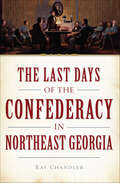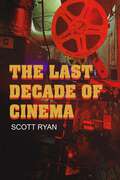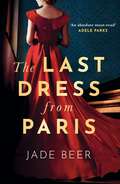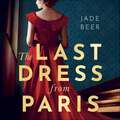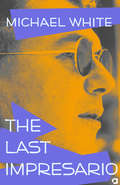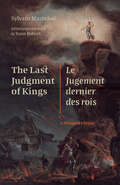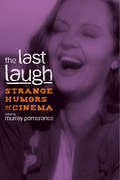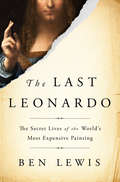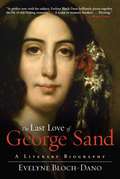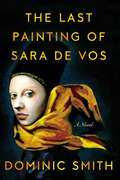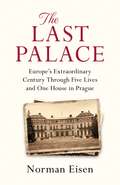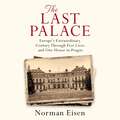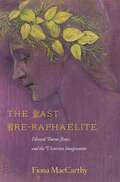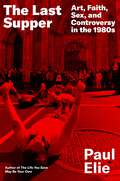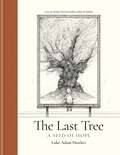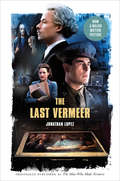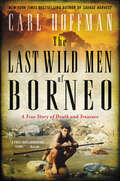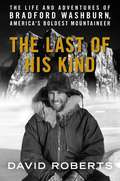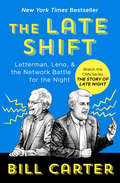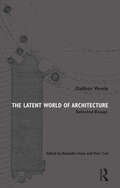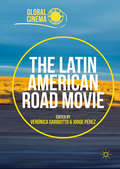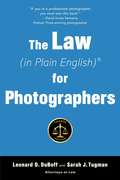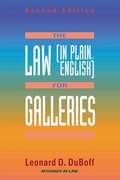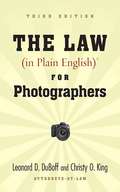- Table View
- List View
The Last Days of the Confederacy in Northeast Georgia (Civil War Series)
by Ray ChandlerIn 1861, northeast Georgians were the driving force into secession and war. In 1865, Confederate president Jefferson Davis, his government collapsing and himself a wanted man, brought the reality of the war to the region's doorstep. Governor Joseph Brown, U.S. senator Robert Toombs and the politically influential Howell Cobb of Athens and his brother Thomas R.R. Cobb all fought passionately for Southern independence. The region epitomized the reasons for which the South waged and supported the war, yet it was spared the destruction seen in other places. Even Sherman's Union army touched only the region's fringes. Author Ray Chandler brings to light the final act of the Confederacy in the Peach State's northeast and the lasting impact it had on Georgians.
The Last Decade of Cinema: Twenty-five Unique Films From The Nineties
by Scott RyanThis provocative tome, sure to foment heated discussions among cinephiles of all generations, argues that the 1990s was the last decade in which films were made for grownups, with complex, adult-based plots, nuanced characters, and meaningful themes.&“I feel like Scott Ryan could have written this directly to me and others in our generation who have basically &‘given up&’ on movies. It is at once tribute and eulogy, so bittersweet.&” – Screenwriter Helen Childress (Reality Bites)&“The nineties are lucky to have Scott Ryan.&” – Actress Natasha Gregson Wagner (Two Girls and a Guy, Lost Highway)Ah, the nineties. Movies were something in those days. We&’re talking about a decade that began with GoodFellas and ended with Magnolia, with such films as Malcolm X, Before Sunrise, and Clueless arriving somewhere in between. Stories, characters, and writing were king; IP, franchise movies, and supersaturated superhero flicks were still years away. Or so says Scott Ryan, the iconoclastic author of The Last Days of Letterman and Moonlighting: An Oral History, who here turns his attention to The Last Decade of Cinema—the prolific 1990s. Ryan, who watched just about every film released during the decade when he was a video store clerk in a small town in Ohio, identifies twenty-five unique and varied films from the decade, including Pretty Woman, Pulp Fiction, Menace II Society, The Prince of Tides, and The Shawshank Redemption, focusing with his trademark humor and insight on what made them classics and why they could never be produced in today&’s film culture. The book also includes interviews with writers, directors, and actors from the era. Go back to the time of VCR&’s, DVD rentals, and movies that mattered. Turn off your streaming services, put down your phones, delete your Twitter account, and take a look back at the nineties with your Eyes Wide Shut, a White Russian in your hand, and yell &“Hasta la vista, baby&” to today&’s meaningless entertainment. Revel in the risk-taking brilliance of Quentin Tarantino, Amy Heckerling, Spike Lee, Robert Altman, Paul Thomas Anderson, and others in Scott Ryan&’s magnum opus, The Last Decade of Cinema.
The Last Dress from Paris: A heartbreaking and sweeping historical novel
by Jade Beer'Kept me spellbound...You can practically feel the heaviness and sumptuousness of the velvet and other lush materials of the vintage gowns in your hands. Secrets and heartbreak come alive in this book I was unable to put down!' Reader review ⭐⭐⭐⭐⭐Each Dior dress tells a story... London, 2017: When her beloved grandmother, Sylvie, sends her to Paris to retrieve a dress she wore decades before, Lucille sees the perfect opportunity to briefly escape the pressures of her own life. But not everything is as it seems, and the long-buried secrets she discovers, hidden in a collection of priceless Dior gowns, could change everything. Paris, 1952: Postwar France is full of glamour and privilege, and Alice Ainsley is in the middle of it all. As the wife to the British ambassador to France, her life is a whirlwind of jewels, banquets and couture dresses, but beneath the glittering facade, Alice is suffocating in a loveless marriage. So when a new face appears in her drawing room, Alice finds herself yearning to follow her heart . . . no matter the consequences. Deliciously evocative and achingly romantic, sweeping from Fifties Paris to the V&A museum in London, The Last Dress from Paris is the perfect read for fans of Taylor Jenkins Reid, Natasha Lester, Fiona Valpy and Gill Paul.Don't miss the new novel from Jade Beer, The Palace Dressmaker, another sweeping tale of love, friendship and the power of fashion to shape our lives... Everyone is falling in love with The Last Dress from Paris:'I'm sipping on a calming cup of tea and dabbing my eyes with a tissue after finishing this book... An excellent read! I love the description of the dresses. Paris in the 1950's... Loved this book!' Reader review ⭐⭐⭐⭐⭐'I couldn't put it down. What a great story. Loved, laughed and cried while reading it' Reader review ⭐⭐⭐⭐⭐'A delightful story of unrequited love, haute couture fashion, friendship, and secrets!... I read this one late into the night... I enjoyed the descriptions of the dresses, as well as the scenic locations in Paris. Secrets were gradually revealed, right up to the satisfying conclusion' Reader review ⭐⭐⭐⭐⭐'I loved this book!!... Bittersweet and with a mystery at its heart... A great read!' Reader review ⭐⭐⭐⭐⭐'Some books stick with you throughout reading and after finishing it. This is one of those books!... When I tell you that I loved this book, I mean it!!... Fashion, forbidden love, heartbreak... I HIGHLY recommend this book' Reader review ⭐⭐⭐⭐⭐'A brilliant book that will stay with me for a long time... A thoroughly engrossing novel of strong love' Reader review ⭐⭐⭐⭐⭐ 'A delightful fashion treasure hunt involving some of my favourite Dior gowns... The dresses dance from the pages, and Paris is resplendently depicted' Natasha Lester 'A whirlwind tour through Paris, both past and present, the novel is a rich exploration of the power of female friendships and the true meaning of family. Moving and utterly enjoyable' Fiona Davis 'An absolute delight!... As original, elegant, and romantic as the Dior dresses the novel's mystery is woven around' Hazel Gaynor 'As beautifully stitched together as a couture gown... I loved it' Jessica Fellowes 'Sumptuous, evocative and dripping in Parisian elegance. A beautifully written page-turner' Kate Thompson 'My kind of read, with vintage couture gowns, Parisian elegance, and romance across the ages' Gill Paul
The Last Dress from Paris: The glamorous, romantic dual-timeline read of summer 2022
by Jade BeerA sweeping dual-narrative love story sweeping from 1950s Paris to the V&A Museum in London, told through eight couture dresses that reunite three generations of women.Each Dior dress tells a story...London, 2017. When her beloved grandmother, Sylvie, sends her to Paris to retrieve a dress she wore decades before, Lucille sees the perfect opportunity to briefly escape the pressures of her own life. But not everything is as it seems, and the long-buried secrets she discovers, hidden in a collection of priceless Dior gowns, could change everything.Paris, 1952. Postwar France is full of glamour and privilege, and Alice Ainsley is in the middle of it all. As the wife to the British ambassador to France, her life is a whirlwind of jewels, banquets and couture dresses, but beneath the glittering facade, Alice is suffocating in a loveless marriage. So when a new face appears in her drawing room, Alice finds herself yearning to follow her heart . . . no matter the consequences.Deliciously evocative and achingly romantic, sweeping from 50s Paris to the V&A museum in London, The Last Dress from Paris is the perfect read for fans of Natasha Lester, Fiona Valpy and Gill Paul'A delightful fashion treasure hunt involving some of my favorite Dior gowns made this book a winner for me! The present day and 1950s narratives weave seamlessly together, the dresses dance from the pages, and Paris is resplendently depicted'-Natasha Lester, New York Times bestselling author of The Paris Secret(P) 2022 Penguin Audio
The Last Impresario
by Michael WhiteThe Last Impresario--the most famous person you've never heard of--is now the subject of a major motion picture, directed by Gracie Otto. Michael White is one of the most inspirational producers of our time, responsible for changing the face of Britain's cultural scene in the 1970s. White has been involved in an amazingly wide range of shows, many of them hits, some of them disastrous failures, all of them unusual. His career encompasses the plays of Athol Fugard, Joe Orton's Loot, Oh! Calcutta!, the catastrophic Jeeves, the money-spinning Sleuth, The Threepenny Opera, starring Vanessa Redgrave, The Rocky Horror Show, and movies ranging from My Dinner with Andre to Monty Python cannot, by the wildest stretch of the imagination, be dubbed conventional. In this autobiography, originally published as Empty Seats in 1984, Michael White tells many marvelous stories and asks some wonderful questions. Why did Orson Welles make a one-armed Peter Daubeny carry his suitcases? What really happened during a performance of The Dirtiest Show in Town? What did Peter Sellers do to Spike Milligan's roast chicken? What were Kenneth Tynan, Joe Orton, and Dame Edna Everage really like? The reader discovers how a play is put on, what kind of money is involved, what techniques are used. "You, too," White seems to say, "can be a producer. And this is how you set about it." Drawing on all too many experiences he might prefer to forget, White would no doubt add, "And that way madness lies."
The Last Judgment of Kings / Le Jugement dernier des rois: A Bilingual Edition (Scènes francophones: Studies in French and Francophone Theater)
by Sylvain Maréchal (1750-1803)First performed the day after Marie-Antoinette’s beheading, Le Jugement dernier des rois stages the burlesque trial of the remaining kings and queens of Europe—paraded in chains like animals, made to brawl over a barrel of crackers, and finally obliterated by a spectacular volcanic eruption. Such is the shocking context—at once tragic and farcical—of the most infamous play of the French Revolution, familiar to all specialists of the period. Until now, however, no standalone critical edition or English translation of this historic play existed. This bilingual edition revives Maréchal’s play and reveals its centrality to scholarly debates about Revolutionary notions of justice, religion, commemoration, comedy, and propaganda. Provocative, written in accessible prose, and short—perfect for students in a French or history seminar—Le Jugement dernier des rois offers an ideal introduction to the most important and contentious questions of the Revolutionary period. Joué pour la première fois le lendemain de l’exécution de Marie-Antoinette, Le Jugement dernier des rois met en scène le procès burlesque des autres rois et reines d’Europe : exhibés et enchaînés tels des animaux, contraints de se battre pour un tonneau de biscuits, et finalement anéantis par l’éruption spectaculaire d’un volcan. Tel est le contexte scandaleux—tragédie et farce à la fois—de la pièce la plus célèbre de la Révolution française, bien connue de tous les spécialistes de cette période. Jusqu’à maintenant, pourtant, il n’existait ni édition critique ni traduction anglaise de cet ouvrage historique. Notre édition bilingue fait revivre la pièce de Maréchal et la replace au centre des plus grands débats chez les historiens de la Révolution, traitant de justice, religion, commémoration, comédie, et propagande. Provocateur, facile à lire, et concis—parfaitement adapté aux étudiants d’un cours de français ou d’histoire—Le Jugement dernier des rois propose ainsi une introduction idéale à la période révolutionnaire et à ses principales controverses. Published by Bucknell University Press. Distributed worldwide by Rutgers University Press.
The Last Laugh: Strange Humors of Cinema (Contemporary Approaches To Film And Media Ser.)
by Murray PomeranceFor critics, fans, and scholars of drama and film, the laugh has traditionally been tied to comedy, indicating and expressing mirth, witty relief, joyous celebration, or arch and sarcastic parody. But strange, dark laughter that illuminates non-comedic, unfunny situations gets much less attention. In The Last Laugh: Strange Humors of Cinema, editor Murray Pomerance has assembled contributions from thirteen estimable scholars that address the strange laughter of cinema from varying intellectual perspectives and a wide range of sources. Contributors consider unusual humors in a variety of filmic settings, from the chilling unheard laughter of silent cinema to the ribald and mortal laughter in the work of Orson Welles; the vagaries and nuances of laughter in film noir to the eccentric laughter of science fiction. Essays also look at laughter in many different applications, from the subtle, underlying wit of the thriller Don't Look Now to the deeply provocative humor of experimental film and the unpredictable, shadowy, insightful, and stunning laughter in such films as Black Swan, Henry Fool, The Treasure of the Sierra Madre, Kiss of Death, The Dark Knight, and A.I. Artificial Intelligence. The accessibly written, unique essays in The Last Laugh bring a new understanding to the delicate balance, unsettled tensions, and fragility of human affairs depicted by strange humor in film. For scholars of film and readers who love cinema, these essays will be rich and playful inspiration.
The Last Leonardo: The Secret Lives of the World's Most Expensive Painting
by Ben LewisAn epic quest exposes hidden truths about Leonardo da Vinci’s Salvator Mundi, the recently discovered masterpiece that sold for $450 million—and might not be the real thing. In 2017, Leonardo da Vinci’s small oil painting the Salvator Mundi was sold at auction. In the words of its discoverer, the image of Christ as savior of the world is “the rarest thing on the planet.” Its $450 million sale price also makes it the world’s most expensive painting. <P><P>For two centuries, art dealers had searched in vain for the Holy Grail of art history: a portrait of Christ as the Salvator Mundi by Leonardo da Vinci. Many similar paintings of greatly varying quality had been executed by Leonardo’s assistants in the early sixteenth century. But where was the original by the master himself? <P><P>In November 2017, Christie’s auction house announced they had it. But did they? The Last Leonardo tells a thrilling tale of a spellbinding icon invested with the power to make or break the reputations of scholars, billionaires, kings, and sheikhs. Ben Lewis takes us to Leonardo’s studio in Renaissance Italy; to the court of Charles I and the English Civil War; to Amsterdam, Moscow, and New Orleans; to the galleries, salerooms, and restorer’s workshop as the painting slowly, painstakingly emerged from obscurity. <P><P>The vicissitudes of the highly secretive art market are charted across six centuries. It is a twisting tale of geniuses and oligarchs, double-crossings and disappearances, in which we’re never quite certain what to believe. Above all, it is an adventure story about the search for lost treasure, and a quest for the truth.
The Last Love of George Sand: A Literary Biography
by Evelyne Bloch-DanoGeorge Sand is one the most celebrated writers and controversial personalities of nineteenth-century France; she is as famous for her bohemian lifestyle as for her written work. The Last Love of George Sand portrays the writer, political activist, and cultural figure as she starts a new chapter in her ever-surprising life: the mature years with her last lover, the young and talented engraver Alexandre Manceau. A turning point came for George Sand in 1849. After her political involvement in the revolution of 1848, Sand retreated to her country property, Nohant, with her son Maurice and started writing new plays. One day, Maurice introduced her to Alexandre Manceau, a young and shy artist thirteen years her junior. At forty-five, she was at the pinnacle of her career. She had a long history of tumultuous love affairs with famous artists such as Musset, Chopin, and Mérimée, but she had never experienced a peaceful and balanced relationship. With Manceau, Sand discovered that she could be loved, and fall in love herself, without drama. Their relationship would last fifteen years, and prove to be the most prolific period of Sand's life, with fifty books published including the novels Elle et lui, inspired by her relationship with Musset, and Le dernier amour, written just ten days after Manceau died of tuberculosis. Although much has been written about George Sand, most of the previous biographies are focused on her more turbulent times. In The Last Love of George Sand, Evelyne Bloch-Dano looks back on Sand's life from the vantage point of her years with Manceau.
The Last Painting of Sara De Vos
by Dominic Smith“Written in prose so clear that we absorb its images as if by mind meld, “The Last Painting” is gorgeous storytelling: wry, playful, and utterly alive, with an almost tactile awareness of the emotional contours of the human heart. Vividly detailed, acutely sensitive to stratifications of gender and class, it’s fiction that keeps you up at night — first because you’re barreling through the book, then because you’ve slowed your pace to a crawl, savoring the suspense. ” —Boston Globe ANew York Times Bestseller A New York Times Book Review Editor's Choice A RARE SEVENTEENTH-CENTURY PAINTING LINKS THREE LIVES, ON THREE CONTINENTS, OVER THREE CENTURIES INTHE LAST PAINTING OF SARA DE VOS, AN EXHILARATING NEW NOVEL FROM DOMINIC SMITH. Amsterdam, 1631: Sara de Vos becomes the first woman to be admitted as a master painter to the city’s Guild of St. Luke. Though women do not paint landscapes (they are generally restricted to indoor subjects), a wintry outdoor scene haunts Sara: She cannot shake the image of a young girl from a nearby village, standing alone beside a silver birch at dusk, staring out at a group of skaters on the frozen river below. Defying the expectations of her time, she decides to paint it. New York City, 1957: The only known surviving work of Sara de Vos,At the Edge of a Wood, hangs in the bedroom of a wealthy Manhattan lawyer, Marty de Groot, a descendant of the original owner. It is a beautiful but comfortless landscape. The lawyer’s marriage is prominent but comfortless, too. When a struggling art history grad student, Ellie Shipley, agrees to forge the painting for a dubious art dealer, she finds herself entangled with its owner in ways no one could predict. Sydney, 2000: Now a celebrated art historian and curator, Ellie Shipley is mounting an exhibition in her field of specialization: female painters of the Dutch Golden Age. When it becomes apparent that both the original At the Edge of a Wood and her forgery are en route to her museum, the life she has carefully constructed threatens to unravel entirely and irrevocably.
The Last Palace: Europe's Extraordinary Century Through Five Lives and One House in Prague
by Norman EisenWhen Norman Eisen moved into the US ambassador's residence in Prague, returning to the land his mother had fled after the Holocaust, he was startled to discover swastikas hidden beneath the furniture. From that discovery unspooled the captivating, twisting tale of the remarkable people who lived in the house before Eisen. Their story is Europe's, telling the dramatic and surprisingly cyclical tale of the endurance of liberal democracy: the optimistic Jewish financial baron who built the palace; the conflicted Nazi general who put his life at risk for the house during World War II; the first postwar US ambassador struggling to save both the palace and Prague from communist hands; the child star- turned-diplomat who fought to end totalitarianism; and Eisen's own mother, whose life demonstrates how those without power and privilege moved through history.The Last Palace chronicles the upheavals that have transformed the continent over the past century and reveals how we never live far from the past.
The Last Palace: Europe's Extraordinary Century Through Five Lives and One House in Prague
by Norman EisenWhen Norman Eisen moved into the US ambassador's residence in Prague, returning to the land his mother had fled after the Holocaust, he was startled to discover swastikas hidden beneath the furniture. From that discovery unspooled the captivating, twisting tale of the remarkable people who lived in the house before Eisen. Their story is Europe's, telling the dramatic and surprisingly cyclical tale of the endurance of liberal democracy: the optimistic Jewish financial baron who built the palace; the conflicted Nazi general who put his life at risk for the house during World War II; the first postwar US ambassador struggling to save both the palace and Prague from communist hands; the child star- turned-diplomat who fought to end totalitarianism; and Eisen's own mother, whose life demonstrates how those without power and privilege moved through history.The Last Palace chronicles the upheavals that have transformed the continent over the past century and reveals how we never live far from the past.(P)2018 Penguin Random House LLC
The Last Pre-Raphaelite: Edward Burne-Jones and the Victorian Imagination
by Fiona MaccarthyWhile still a student at Oxford, Edward Burne-Jones formed a friendship and made a renunciation that would shape art history. The friendship was with William Morris, with whom he would occupy the social and intellectual center of the era’s cult of beauty. The renunciation was of his intention to enter the clergy, when he-together with Morris-vowed to throw over the Church in favor of art. In Fiona MacCarthy’s riveting account of Burne-Jones’s life, that exchange of faith for art places him at the intersection of the nineteenth century and the Modern, as he leads us forward from Victorian mores and attitudes to the psychological, sexual, and artistic audacity that would characterize the early twentieth century. In MacCarthy’s hands, Burne-Jones emerges as a great visionary painter, a master of mystic reverie, and a pivotal late nineteenth-century cultural and artistic figure. Lavishly illustrated with color plates, The Last Pre-Raphaelite shows that Burne-Jones’s influence extended far beyond his own circle to Freudian Vienna and the delicately gilded erotic dream paintings of Gustav Klimt, the Swiss Symbolist painter Ferdinand Hodler, and the young Pablo Picasso and the Catalan painters. Drawing on extensive research, MacCarthy offers a fresh perspective on the achievement of Burne-Jones, a precursor to the Modern, and tells the dramatic, fascinating story of this peculiarly captivating and elusive man.
The Last Supper: Art, Faith, Sex, and Controversy in the 1980s
by Paul ElieThis enthralling group portrait brings to life a moment when popular culture became the site of religious strife—strife that set the stage for some of the most salient political and cultural clashes of our day. Circa 1980, tradition and authority are in the ascendant, both in Catholicism (via Pope John Paul II) and in American civic life (through the Moral Majority and the so-called televangelists). But the public is deeply divided on issues of body and soul, devotion and desire. Enter the figures Paul Elie calls “cryptoreligious.” Here is Leonard Cohen writing “Hallelujah” on his knees in a Times Square hotel room; Andy Warhol adapting Leonardo’s The Last Supper in response to the AIDS pandemic; Prince making the cross and altar into “signs o’ the times.” Through Toni Morrison, spirits speak from the grave; Patti Smith and Bruce Springsteen deepen the tent-revival intensity of their work; Wim Wenders offers an angel’s-eye view of Berlin; U2, the Neville Brothers, and Sinéad O’Connor reckon with their Christian roots in music of mystic yearning. And Martin Scorsese overcomes fundamentalist ire to make The Last Temptation of Christ—a struggle that anticipates Salman Rushdie’s struggle with Islam in The Satanic Verses. In Elie’s acclaimed first book, The Life You Save May Be Your Own, Catholic writers ventured out into the wilds of postwar America; in this book, creative figures who were raised religious go to the margins of conventional belief, calling forth controversy. Episodes such as the boycott sparked by Madonna’s “Like a Prayer” video and the tearing-up of Andres Serrano’s Piss Christ in Congress are early skirmishes in the culture wars—but here the creators (not the politicians) are the protagonists, and the work they make speaks to conflicts that remain unsettled. The Last Supper explores the bold and unexpected forms an encounter with belief can take. It traces the beginnings of our postsecular age, in which religion is at once surging and in decline. Through a propulsive narrative, it reveals the crypto-religious imagination as complex, credible, daring, and vividly recognizable.
The Last Tree: A Seed of Hope
by Luke Adam HawkerFrom the Sunday Times bestselling author of Together. Imagine a world without trees. A world that is in many ways like our world, but where magnificent canopies, tree climbing and leaves rustling in the breeze are now only distant memories.Until a young girl comes along, a girl who is brave and spirited and willing to follow where her imagination takes her. Through Olive's adventures in the world of trees we are reminded of nature's extraordinary power and beauty, and her actions ultimately sow the seeds of new life in her own world.From the mind and pen of bestselling author Luke Adam Hawker, The Last Tree is a powerful evocation of the fragility of our natural world and a magnificent celebration of its beauty.Praise for Together:"An accurate and thoughtful account of one of the most challenging years in modern history." -The Guardian"Hawker's images always seem to have just the right mixture of gravitas and sly, understated humour." -The Scotsman
The Last Vermeer: Unvarnishing the Legend of Master Forger Han van Meegeren
by Jonathan Lopez“A grand yarn of twisty deceit, involving prestigious dupes and scads of money, with a sensational trial at the finish.” —The New YorkerIt’s a story that made Dutch painter Han van Meegeren world-famous when it broke at the end of World War II: A lifetime of disappointment drove him to forge Vermeers, one of which he sold to Hermann Goering in mockery of the Nazis. And it’s a story that’s been believed ever since. Too bad it isn't true.Jonathan Lopez has drawn on never-before-seen documents from dozens of archives for this long-overdue unvarnishing of Van Meegeren’s legend. Neither unappreciated artist nor antifascist hero, Van Meegeren emerges as an ingenious, dyed-in-the-wool crook. Lopez explores a network of illicit commerce that operated across Europe: Not only was Van Meegeren a key player in that high-stakes game in the 1920s and ’30s, landing fakes with famous collectors such as Andrew Mellon, but he and his associates later cashed in on the Nazi occupation.Nominated for an Edgar Award and made into a film starring Guy Pearce, The Last Vermeer is a revelatory biography of the world’s most famous forger—a talented Mr. Ripley armed with a paintbrush—and a deliciously detailed story of deceit in the art world.Includes photographs“His pioneering research on van Meegeren’s early life gives us further insight into what motivates deception, a subject that will never cease to fascinate as long as art is bought and sold.” —ARTNews“Brings hard light to van Meegeren’s machinations and (very bad) character.” —The New Yorker“Fascinating . . . Lopez’s writing is witty, crisp and vigorous, his research scrupulous and his pacing dynamic.” —Publishers Weekly (starred review)“A terrific read.” —Houston Chronicle“It’s hard to imagine improving on Lopez’s gem of a tale.” —Los Angeles TimesPreviously published as The Man Who Made Vermeers
The Last Wild Men of Borneo: A True Story of Death and Treasure
by Carl HoffmanA 2019 EDGAR AWARDS NOMINEE (BEST FACT CRIME) • A BANFF MOUNTAIN BOOK AWARDS FINALISTTwo modern adventurers sought a treasure possessed by the legendary “Wild Men of Borneo.” One found riches. The other vanished forever into an endless jungle. Had he shed civilization—or lost his mind? Global headlines suspected murder. Lured by these mysteries, New York Times bestselling author Carl Hoffman journeyed to find the truth, discovering that nothing is as it seems in the world’s last Eden, where the lines between sinner and saint blur into one.In 1984, Swiss traveler Bruno Manser joined an expedition to the Mulu caves on Borneo, the planet’s third largest island. There he slipped into the forest interior to make contact with the Penan, an indigenous tribe of peace-loving nomads living among the Dayak people, the fabled “Headhunters of Borneo.” Bruno lived for years with the Penan, gaining acceptance as a member of the tribe. However, when commercial logging began devouring the Penan’s homeland, Bruno led the tribe against these outside forces, earning him status as an enemy of the state, but also worldwide fame as an environmental hero. He escaped captivity under gunfire twice, but the strain took a psychological toll. Then, in 2000, Bruno disappeared without a trace. Had he become a madman, a hermit, or a martyr?American Michael Palmieri is, in many ways, Bruno’s opposite. Evading the Vietnam War, the Californian wandered the world, finally settling in Bali in the 1970s. From there, he staged expeditions into the Bornean jungle to acquire astonishing art and artifacts from the Dayaks. He would become one of the world’s most successful tribal-art field collectors, supplying sacred works to prestigious museums and wealthy private collectors. And yet suspicion shadowed this self-styled buccaneer who made his living extracting the treasure of the Dayak: Was he preserving or exploiting native culture?As Carl Hoffman unravels the deepening riddle of Bruno’s disappearance and seeks answers to the questions surrounding both men, it becomes clear saint and sinner are not so easily defined and Michael and Bruno are, in a sense, two parts of one whole: each spent his life in pursuit of the sacred fire of indigenous people. The Last Wild Men of Borneo is the product of Hoffman’s extensive travels to the region, guided by Penan through jungle paths traveled by Bruno and by Palmieri himself up rivers to remote villages. Hoffman also draws on exclusive interviews with Manser’s family and colleagues, and rare access to his letters and journals. Here is a peerless adventure propelled by the entwined lives of two singular, enigmatic men whose stories reveal both the grandeur and the precarious fate of the wildest place on earth.
The Last of His Kind: The Life and Adventures of Bradford Washburn, America's Boldest Mountaineer
by David Roberts“A breezy, readable volume that is one part adventure story, one part biography. . . . Tales, stunning and stirring, of mountaineering.” —Boston GlobeIn The Last of His Kind, renowned adventure writer David Roberts gives readers a spellbinding history of mountain climbing in the twentieth century as told through the biography of Brad Washburn, legendary mountaineering pioneer and photographer. Jon Krakauer, author of Into Thin Air, has praised David Roberts, saying, “Nobody alive writes better about mountaineering”—and nowhere is that truth more evident than in this breathtaking account of the life and exploits of America’s greatest mountain climber.“A longtime friend of Washburn and a former mountaineer, Roberts is an ideal candidate for writing Washburn's biography.” —Publishers Weekly“Part of the reason that David Roberts's biography of mountain climber Bradford Washburn is titled “The Last of His Kind” is that so often Washburn was the first of his kind: He achieved nine first ascents of peaks in North America alone, taking striking photographs along the way.” —Washington Post“Excellent.” —Booklist“A well-crafted biography. . . . Roberts’s style effectively captures the suspense and danger of Washburn’s adventures. A thorough and admiring portrait.” —Kirkus Reviews
The Late Shift: Letterman, Leno, & the Network Battle for the Night
by Bill CarterNew York Times Bestseller: A “gripping” true story of late-night comedy and behind-the-scenes drama (Los Angeles Times). When beloved host Johnny Carson announced his retirement after thirty years on The Tonight Show, millions of Americans mourned. But inside the television industry, the news ignited a battle between two amazing talents—Jay Leno and David Letterman—who both yearned to occupy the departing legend’s chair. For NBC, it would be a decision with millions of dollars at stake. Soon these two comedians with strikingly different styles, who had once shared a friendship as they worked the clubs together, would be engaged in a fierce competition for the prize. Based on in-depth reporting and interviews with those involved, and updated with a new introduction by the author, The Late Shift is a “vivid, behind-the-scenes, blow-by-blow account” of the fight that ensued, as stars, agents, and executives maneuvered for control of the most profitable program in TV history (Chicago Tribune). “Remarkably gripping . . . Takes us deep into the bizarre high-stakes world of broadcasting . . . A powerful story, and ultimately a sad one, filled with casualties as well as winners.” —The New York Times Book Review “Solid reporting, based on extensive interviews with the principals, lifts The Late Shift into a class of its own. . . . The insights into the people involved are what make [the book] a page-turner.” —Orange Country Register
The Latent World of Architecture: Selected Essays
by Dalibor VeselyThis book features thirteen essays by the late architect, philosopher and teacher Dalibor Vesely (1934–2015). Vesely was a leading authority on philosophical hermeneutics and phenomenology in relation to architecture worldwide, and influenced a generation of thinkers, teachers and practitioners. This collection presents the full range of his writing, drawing primarily from the history of art and architecture, as well as philosophy, theology, anthropology and ecology, and spanning from early antiquity to modernism. It composes a multifaceted and globally relevant argument about the enduring cultural role of architecture and the significance of its history. The book, edited and introduced by Vesely’s teaching partner at Cambridge Peter Carl and former student Alexandra Stara, and with a foreword by David Leatherbarrow, brings to light new and hard-to-access material for those familiar with Vesely’s thought and, at the same time, offers a compelling introduction to his writing and its profound relevance for architecture and culture today.
The Latin American Road Movie
by Verónica Garibotto Jorge PérezThis volume explores the ways films made by Latin American directors and/or co-produced in Latin American countries have employed the road movie genre to address the reconfiguration of the geographical, sociopolitical, economic, and cultural landscape of Latin America.
The Lavender Companion: Enjoy the Aroma, Flavor, and Health Benefits of This Classic Herb
by Jessica Dunham Terry Barlin VesciA celebration of lavender featuring stunning photographs; favorite recipes for the kitchen, pantry, and body care products; along with fascinating lore and gardening guidance from a destination lavender farm. Lavender has long been a favorite herb with its amazing, resinous fragrance; calming qualities; and unique flavor for seasoning food. This lavishly photographed celebration of the beloved herb, written by an acclaimed lavender farmer and cooking instructor, is brimming over with inspiration and ideas for bringing the fragrance and flavor of lavender into daily life. The book profiles the most popular lavender varieties and their recommended uses, along with the history, lore, and traditional medicinal uses. More than 40 recipes showcase lavender in delicious dishes from the kitchen as well homemade craft and body products. Tips for success with lavender in the garden complete this perfect gift for every lavender lover.
The Law (In Plain English)
by Leonard D. DuBoff Sarah J. Tugman&“If you&’re a professional photographer, you must own this book.&” —David Hume Kennerly, Pulitzer Prize winner, former White House photographer, University of Arizona presidential scholar The All-in-One Resource for Photographers at All Levels In The Law (in Plain English)® for Photographers, Leonard D. DuBoff and Sarah J. Tugman walk readers through the legal landscape of the photography business. In easy-to-understand terms and with plenty of examples, this comprehensive resource covers everything from organizing a business to privacy rights to copyright questions. Clearly outlined chapters will help readers to:Comprehend intellectual property lawsIdentify defamation and libelDistinguish rights of privacy and publicityNavigate censorship and obscenity rulesUnderstand photo licenses and restrictionsOrganize a photography businessDraft strong contracts and resolve disputesProperly file taxes and take advantage of deductionsSelect and utilize insurance plansPrepare an estate plan To master the legal side of the business, all photographers need to have this essential guide in their libraries.
The Law (in Plain English) for Galleries
by Leonard D. DuboffThe second edition of this definitive guide is for gallery owners, dealers, and artists' reps who want to understand the law and successfully tackle the business and legal issues they face every day in their field. Written by an esteemed arts lawyer and lecturer, the book covers all legal aspects of a gallery businessfrom trademarks and copyright to contracts, consignments, taxes, product liability, advertising, catalog sales, and customer relationssaving the reader thousands of dollars in attorney's fees. The author also advises how to find a good lawyer if one is needed.
The Law (in Plain English) for Photographers
by Leonard D. DuboffThe revisions for this third edition cover key digital issues, such as the Copyright Office's new online registration process; post-9/11 rules for shooting in "sensitive" environments; and updates to right of privacy laws. Not only can this book save thousands in attorney's fees, it also explains how to find good legal assistance when necessary. Readers will find information on:--censorship and obscenity--the rights of privacy and publicity--organizing as a business--tax deductions for the home office--relevant court cases--photography organizations--releases, contracts, and other forms
